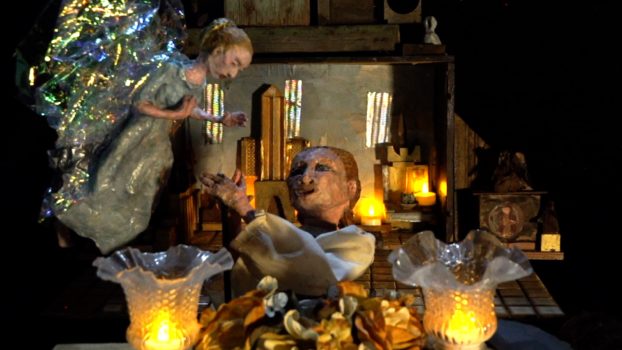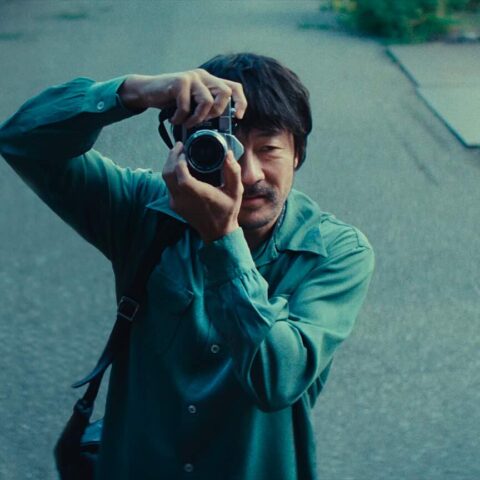Spectre’s Bride is a macabre tale of an undead spirit attempting to take an innocent maiden on a journey to the underworld.
In August 2018, Francesca Borgatta was searching for a folktale with the theme of conflicted love for her next video. She attended a rehearsal of the of Antonin Dvořák’s “Spectre’s Bride” sung by the Berkeley Community Chorus, and she was awed by the wild and unexpected tonalities and raw emotional power of the music. Karel Jaromir Erben had collected the Czech folktale that he used for a narrative poem, which Dvořák took as the text of the cantata. The plot is concise and dramatic; an abandoned bride is abducted by a spectre who claims to be her lover. The spectre takes the maiden through landscapes that become increasingly more abstract and terrifying as he divests her of the objects of her faith: prayer book, cross, rosary, and finally, her wedding clothes. Only the strength of her faith can save her.

As a visual artist making puppets and installations, Francesca combines re-cycled materials and papier mache in her construction. In her studio she began to work on the four sets that define the basic action: the bride’s room, a dark forest, a spectral landscape, and a crypt. After each test shot the edges of the set needed to be extended so the camera could explore different angles. The plan was to film the puppet action in front of a green screen, then add the set footage to make a changing background.
The characters of Spectre and Maiden were portrayed by two 18-inch puppets, using rods to manipulate the limbs from beneath the stage level. The story calls for simple, iconic actions; the Bride drops her rosary, the Spectre steals her cross. The three puppeteers were dancers who were sensitive to the music could manipulate the characters with precision and control. Even so, many takes were required to capture the gestures.
Soon, Francesca realized that a smaller, 200 mm., version of the puppets were needed to inhabit the landscape. In addition, she brought in two 25 mm. figures on strings to give more dimension to their journey. Several symbolic figures: moon, owl, howling dogs, were used to frame the scenes. Many spook figures lying around the studio found their way into the sets.
As the filming progressed, a revolving table was added to intensify the image of wild flight. A smoke machine and a wind machine created extra fear and mystery.

The editing was an intensive process which Francesca shared with the videographer, Graham Bond. Her task was to identify the best footage, place the clips in sequence, and determine the approximate duration. Then Graham would use his experienced eye to expand the possibilities for altering the image, adding dissolves and super-impositions. The nighttime setting of the story and the Spectre’s ethereal nature worked well for the video. The light could penetrate the Spectre’s body, he could dissolve and re-appear out of rocks and tree branches. In last scene, the Maiden’s dream, she sits alone in the graveyard as a re-play of images from the night before passes through her mind.
In March, the videographer took the rough cut of the prayer scene and added the soundtrack. The gestures were carefully choreographed to capture the musical intention. The initial concept of making the music visible seemed possible. In June, the second cut was ready on the timeline with the soundtrack. Over the summer they continued with the fine tuning of the elements. She learned how to use slight shifts in color or timing to transform the image. The videographer’s constant admonition: ‘Where is the story? I want to see the story’ was essential to enhance the emotional impact. Francesca says, “I hope to do honor to Antonin Dvořák by offering this video with his beautiful music.”

Artist’s statement:
“For my next video project the puppets and text are ready. The plan is to use large puppets in natural locations. The production will employ a spoken chorus, and electronic music will be coordinated with natural sounds. At this time, I am reaching out to artists, performers, and digital composers to build a new team and join me in the creative process.
Francesca Borgatta is a visual artist, poet and dramatist. She makes masks and puppets, and choreographs her own theatrical productions. She prepares events and installations in collaboration with other artists. Video has increasingly become a way to combine her skills of poetry, visual arts, and puppetry to make a product she can offer easily to people.
www.puppetfigures.com

